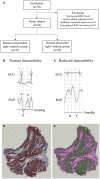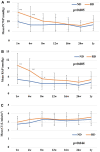Effect of a reduced donor heart right ventricular distensibility on post-heart transplant haemodynamics
- PMID: 33232450
- PMCID: PMC8906735
- DOI: 10.1093/icvts/ivaa222
Effect of a reduced donor heart right ventricular distensibility on post-heart transplant haemodynamics
Abstract
Objectives: This study aimed to investigate the characteristics of a reduced right ventricular distensibility after heart transplant.
Methods: This study enrolled 64 adult patients who underwent heart transplant at our institution. The degree of right ventricular distensibility was quantified by calculating the difference between right atrial pressures (RAPs) of X descent and Y descent (X-Y) from the RAP waveform in right heart catheterization. Histologically, the ratio of the interstitial tissue in myocardial biopsy samples was calculated.
Results: Of the 64 patients, 35 (55%) had a reduced right ventricular distensibility at 1 week after heart transplant (X-Y > 1 mmHg, RD group), and 29 (45%) had a normal right ventricular distensibility (X-Y ≤ 1 mmHg, ND group). The mean RAP and mean pulmonary capillary wedge pressure 1 week after heart transplant in the RD group were significantly higher than that in the ND group. The mean RAP and mean pulmonary capillary wedge pressure in the RD group gradually normalized 12 weeks postoperation. The ratio of the interstitial tissue of biopsy samples significantly correlated with the X-Y value. The number of patients who required inotropic support >14 days was higher in the RD group than in the ND group.
Conclusions: Reduced donor heart distensibility was a common impairment early after heart transplant. It might result from interstitial oedema in the myocardial tissue of the donor heart. Reduced donor heart distensibility after heart transplant might be associated with early clinical outcomes; however, further investigation is required.
Keywords: Donor heart; Haemodynamics; Heart transplant; Ventricular distensibility.
© The Author(s) 2020. Published by Oxford University Press on behalf of the European Association for Cardio-Thoracic Surgery. All rights reserved.
Figures






Similar articles
-
Left atrial deformation predicts pulmonary capillary wedge pressure in pediatric heart transplant recipients.Echocardiography. 2015 Mar;32(3):535-40. doi: 10.1111/echo.12679. Epub 2014 Jul 5. Echocardiography. 2015. PMID: 25039265 Clinical Trial.
-
Right Atrial Pressure Waveform Predicts Right Ventricular Failure After Left Ventricular Assist Device Implantation.Ann Thorac Surg. 2019 Nov;108(5):1361-1368. doi: 10.1016/j.athoracsur.2019.04.050. Epub 2019 Jun 5. Ann Thorac Surg. 2019. PMID: 31175868
-
Normalisation of haemodynamics in patients with end-stage heart failure with continuous-flow left ventricular assist device therapy.Heart Lung Circ. 2014 Oct;23(10):963-9. doi: 10.1016/j.hlc.2014.04.259. Epub 2014 Jun 3. Heart Lung Circ. 2014. PMID: 24973864
-
RV dysfunction in pulmonary hypertension is independently related to pulmonary artery stiffness.JACC Cardiovasc Imaging. 2012 Apr;5(4):378-87. doi: 10.1016/j.jcmg.2011.11.020. JACC Cardiovasc Imaging. 2012. PMID: 22498327
-
Relationship of right- to left-sided ventricular filling pressures in advanced heart failure: insights from the ESCAPE trial.Circ Heart Fail. 2013 Mar;6(2):264-70. doi: 10.1161/CIRCHEARTFAILURE.112.000204. Epub 2013 Feb 7. Circ Heart Fail. 2013. PMID: 23392790
Cited by
-
[Anesthesia for organ transplant patients].Anaesthesiologie. 2023 Nov;72(11):773-783. doi: 10.1007/s00101-023-01332-x. Epub 2023 Oct 24. Anaesthesiologie. 2023. PMID: 37874343 Free PMC article. Review. German.
References
-
- Valantine HA, Appleton CP, Hatle LK, Hunt SA, Billingham ME, Shumway NE et al. A hemodynamic and Doppler echocardiographic study of ventricular function in long-term cardiac allograft recipients. Etiology and prognosis of restrictive–constrictive physiology. Circulation 1989;79:66–75. - PubMed
-
- Amende I, Simon R, Seegers A, Daniel W, Heublein B, Hetzer R et al. Diastolic dysfunction during acute cardiac allograft rejection. Circulation 1990;81:66–70. - PubMed
-
- Young JB, Leon CA, Short HD III, Noon GP, Lawrence EC, Whisennand HH et al. Evolution of hemodynamics after orthotopic heart and heart-lung transplantation: early restrictive patterns persisting in occult fashion. J Heart Transplant 1987;6:34–43. - PubMed
-
- Corcos T, Tamburino C, Léger P, Vaissier E, Rossant P, Mattei MF et al. Early and late hemodynamic evaluation after cardiac transplantation: a study of 28 cases. J Am Coll Cardiol 1988;11:264–9. - PubMed
-
- Ishizaka S, Asanoi H, Wada O, Kameyama T, Inoue H. Loading sequence plays an important role in enhanced load sensitivity of left ventricular relaxation in conscious dogs with tachycardia-induced cardiomyopathy. Circulation 1995;92:3560–7. - PubMed
Publication types
MeSH terms
LinkOut - more resources
Full Text Sources
Medical
Miscellaneous

